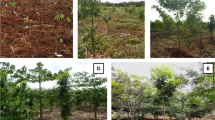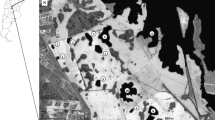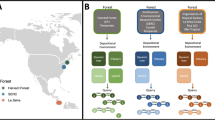Abstract
Creating robust datasets of plant–insect interactions is important for understanding ecosystem dynamics, and data on species interactions can be used to evaluate conservation interventions. In the present work, we collected plant–herbivore–parasitoid data on an understudied but critical ecosystem—gallery forests in the Brazilian cerrado. We collected caterpillars on shrubs of Piper (Piperaceae) over the course of a year in seven gallery forests of varying sizes in order to compare seasonal changes in α- and β- diversity and tritrophic interaction networks as well as the role of fragment size in determining species and interaction diversity. Caterpillars were more abundant and diverse in the wet season and also increased with resource availability—the more Piper individuals present, the greater the abundance and richness of herbivores. The number of unique interactions between (i) plants and herbivores and (ii) herbivores and parasitoids did not change across seasons, but there was a high degree of turnover in the herbivore fauna between sites and seasons. Specialization was greatest in the dry-rainy season transition, when new leaves typically flush. Consistent with records of parasitism rates in the cerrado sensu stricto, parasitism in the gallery forests was greatest in the dry-rainy seasons. Forest size was not related to caterpillar richness. Overall, this work demonstrates the conservation value of gallery forests in supporting plant species that span the Amazon and the Atlantic Rainforest as well as diverse and highly seasonal trophic interactions.



Similar content being viewed by others
Data availability
Data will be shared upon request and will be made available on Dryad (datadryad.org) upon acceptance of the manuscript.
References
Almeida-Neto M, Ulrich W (2011) A straightforward computational approach for measuring nestedness using quantitative matrices. Environ Model Softw 26:173–178. https://doi.org/10.1016/j.envsoft.2010.08.003
Alvares CA, Stape JL, Sentelhas PC, Moraes G, Leonardo J, Sparovek G (2013) Köppen’s climate classification map for Brazil. Meteorol Z 22:711–728
Amorim FW, de Avila RS, de Camargo AJA et al (2009) A hawkmoth crossroads? Species richness, seasonality and biogeographical affinities of Sphingidae in a Brazilian Cerrado. J Biogeogr 36:662–674. https://doi.org/10.1111/j.1365-2699.2008.02033.x
Bersier LF, Banasek-Richter C, Cattin MF (2002) Quantitative descriptors of food-web matrices. Ecol Lett 83:2394–2407
Blüthgen N, Menzel F, Blüthgen N (2006) Measuring specialization in species interaction networks. BMC Ecol 6:1–12
Burger WC (1971) Piperaceae. In: Flora costaricensis. Fieldiana Bot 35:5–227
Callejas-Posada R (2020) Piperaceae. In: Davidse G, Ulloa Ulloa C, Hernández Macías HM, Knapp S (eds) Flora mesoamericana, vol 2. Missouri Botanical Garden Press, St. Louis, pp 1–590
Camargo AJA, Becker VO (1999) Saturniidae (Lepidoptera) from the Brazilian Cerrado: composition and biogeographic relationships. Biotropica 31:696–705
Campos-Moreno DF, Dyer LA, Salcido D, Massad TJ, Pérez-Lachaud G, Tepe EJ, Whitfield JB, Pozo C (2021) Importance of interaction rewiring in determining spatial and temporal turnover of tritrophic (Piper-caterpillar-parasitoid) metanetworks in the Yucatán Península, México. Biotropica. https://doi.org/10.1111/btp.12946
Cardoso D, Särkinen T, Alexander S et al (2017) Amazon plant diversity revealed by a taxonomically verified species list. PNAS 114:10695–10700. https://doi.org/10.1073/pnas.1706756114
Carvalho FMV, De Marco P, Ferreira LG (2009) The Cerrado into-pieces: habitat fragmentation as a function of landscape use in the savannas of central Brazil. Biol Conserv 142:1392–1403. https://doi.org/10.1016/j.biocon.2009.01.031
Chao A, Jost L, Chiang SC et al (2008) A two-stage probabilistic approach to multiple-community similarity indices. Biometrics 64:1178–1186. https://doi.org/10.1111/j.1541-0420.2008.01010.x
Chao A, Gotelli NH, Hsieh TC, Sander EL, Ma KH, Colwell RK, Ellison AM (2014) Rarefaction and extrapolation with Hill numbers: a framework for sampling and estimation in species diversity studies. Ecol Monogr 84:45–67
Chao A, Ma KH, Hsieh TC, Chiu CH (2016) SpadeR (species-richness prediction and diversity estimation in R): an R package in CRAN. Program and user’s guide also published at https://cran.r-project.org/web/packages/SpadeR/SpadeR.pdf. Accessed 24 July 2021
Coley PD, Endara M-J, Kursar TA (2018) Consequences of interspecific variation in defenses and herbivore host choice for the ecology and evolution of Inga, a speciose rainforest tree. Oecologia 187:361–376. https://doi.org/10.1007/s00442-018-4080-z
de Araújo WS, Scareli-Santos C, Guimaraes Guilherme FA, Cuevas-Reyes P (2013) Comparing galling insect richness among neotropical savannas: effects of plant richness, vegetation structure and super-host presence. Biodivers Conserv 22:1083–1094. https://doi.org/10.1007/s10531-013-0474-8
de Araújo WS, Moreira LT, Falcão LAD et al (2019) Superhost plants alter the structure of plant-galling insect networks in neotropical savannas. Plants (Basel) 8:369. https://doi.org/10.3390/plants8100369
de Oliveira-Filho AT, Ratter JA, Shepherd GJ (1990) Floristic composition and community structure of a central Brazilian gallery forest. Flora 184:103–117
Del-Claro K, Dirzo R (2021) Impacts of Anthropocene defaunation on plant-animal interactions. In: Del-Claro K, Torezan-Silingardi (eds) Plant-animal interactions. Springer Nature Switzerland, Switzerland, pp 333–348
Del-Claro K, Torezan-Silingardi HM (2021) An evolutionary perspective on plant-animal interactions. In: Del-Claro K, Torezan-Silingardi (eds) Plant-animal interactions. Springer Nature Switzerland, Switzerland, pp 93–118
Dias BFS (1996) Cerrados: Uma caracterização. In: Dias BFS (ed) Alternativas de desenvolvimento dos Cerrados: manejo e conservação dos recursos naturais renováveis. Fundação Pró-Natureza, Brasília, pp 11–25
Diniz IR, Morais HC (1995) Larvas de Lepidoptera e suas plantas hospedeiras em um cerrado de Brasília, Distrito Federal, Brasil. Rev Bras Entomol 39:755–770
Diniz IR, Morais HC (1997) Lepidopteran caterpillar fauna of cerrado host plants. Biodivers Conserv 6:817–836. https://doi.org/10.1023/B:BIOC.0000010404.17467.6c
Diniz IR, Morais HC (2002) Local pattern of host plant utilization by lepidopteran larvae in the cerrado vegetation. Entomotropica 17:115–119
Diniz IR, Morais HC, Camargo AJA (2001) Host plant of lepidopteran caterpillar in the cerrado of Distrito Federal, Brazil. Rev Bras Entomol 45:107–122
Diniz IR, Braga L, Lepesqueur C, Silva N, Morais HC (2013) Lagartas do Cerrado—Guia de Campo. Technical Books. Rio de Janeiro, Brazil
Dormann CF, Gruber B, Fründ J (2008) Introducing the bipartite package: analysing ecological networks. R News 8:8–11
Dormann CF, Fründ J, Blüthgen N, Gruber B (2009) Indices, graphs and null models: analyzing bipartite ecological networks. Open Ecol J 2:7–24
Dunne JA, Williams RJ, Martinez ND (2002) Network structure and biodiversity loss in food webs: robustness increases with connectance. Ecology 5:558–567
Dyer LA, Walla TR, Greeney HF et al (2010) Diversity of interactions: a metric for studies of biodiversity. Biotropica 42:281–289. https://doi.org/10.1111/j.1744-7429.2009.00624.x
Espinoza CW, Azevedo LG, Jarreta M (1982) O clima da região dos cerrados em relação à agricultura. Planaltina, Brasil: Embrapa-CPAC. Circ Téc 9:15
Forbes AA, Bagley RK, Beer MA et al (2018) Quantifying the unquantifiable: why Hymenoptera, not Coleoptera, is the most speciose animal order. BMC Ecol 18:21. https://doi.org/10.1186/s12898-018-0176-x
Gentry GL, Dyer LA (2002) On the conditional, nature of neotropical caterpillar defenses against their natural enemies. Ecology 83:3108–3119
Glassmire AE, Philbin C, Richards LA et al (2019) Proximity to canopy mediates changes in the defensive chemistry and herbivore loads of an understory tropical shrub, Piper kelleyi. Ecol Lett 22:332–341. https://doi.org/10.1111/ele.13194
Gomes de Moraes M, Machado de Carvalho MA, Franco AC, Pollock CJ, Figueiredo-Ribeiro RCL (2016) Fire and drought: soluble carbohydrate storage and survival mechanisms in herbaceous plants from the Cerrado. Bioscience 66:107–117. https://doi.org/10.1093/biosci/biv178
Gutierrez de Camargo MG, de Carvalho GH, de Costa AB et al (2018) Leafing patterns and leaf exchange strategies of a Cerrado woody community. Biotropica 50:442–454. https://doi.org/10.1111/btp.12552
Hopkins GW, Memmott J (2003) Seasonality of a tropical leaf-mining moth: leaf availability versus enemy-free space. Ecol Entomol 28:687–693. https://doi.org/10.1111/j.1365-2311.2003.00552.x
Hsieh TC, Ma KH, Chao A (2020) iNEXT: iNterpolation and EXTrapolation for species diversity. R package version 2.0.20. https://doi.org/10.1111/2041-210X.12613. Accessed 24 July 2021
Janzen DH, Hallwachs W (2005) Caterpillars, pupae, butterflies & moths of the ACG. http://janzen.sas.upenn.edu/. Accessed 24 July 2021
Janzen DH (1993) Caterpillar seasonality in a Costa Rican dry forest. In: Stamp NE, Casey TM (eds) Caterpillars. Ecological and evolutionary constraints on foraging. Chapman and Hall, New York, pp 448–477
Jost L (2006) Entropy and diversity. Oikos 113:363–375. https://doi.org/10.1111/j.2006.0030-1299.14714.x
Klink CA, Machado RB (2005) Conservation of the Brazilian Cerrado. Conserv Biol 19:707–713. https://doi.org/10.1111/j.1523-1739.2005.00702.x
Koch EBA, Dáttilo W, Camarota F, Vasconcelos HL (2018) From species to individuals: does the variation in ant-plant networks scale result in structural and functional changes? Popul Ecol 60:309–318. https://doi.org/10.1007/s10144-018-0634-5
Kursar TA, Coley PD (2003) Convergence in defense syndromes of young leaves in tropical rainforests. Biochem Syst Ecol 31:929–949. https://doi.org/10.1016/S0305-1978(03)00087-5
Landi P, Minoarivelo HO, Brannstrom A et al (2018) Complexity and stability of ecological networks: a review of the theory. Popul Ecol 60:319–345. https://doi.org/10.1007/s10144-018-0628-3
Lange D, Dáttilo W, Del-Claro K (2013) Influence of extrafloral nectary phenology on ant-plant mutualistic networks in a neotropical savanna. Ecol Entomol 38:463–469. https://doi.org/10.1111/een.12036
Lepesqueur C, Scherrer S, Vieira MC et al (2018) Changing interactions among persistent species as the major driver of seasonal turnover in plant-caterpillar interactions. PLoS ONE 13:1–10. https://doi.org/10.1371/journal.pone.0203164
Lewis OT, Memmott J, Lasalle J et al (2002) Structure of a diverse tropical forest insect-parasitoid community. J Anim Ecol 71:855–873
Lill JT, Marquis RJ, Ricklefs RE (2002) Host plants influence parasitism of forest caterpillars. Nature 417:170. https://doi.org/10.1038/417170a
López-Carretero A, Díaz-Castelazo C, Boege K, Rico-Gray V (2014) Evaluating the spatio-temporal factors that structure network parameters of plant-herbivore interactions. PLoS ONE 9:e110430. https://doi.org/10.1371/journal.pone.0110430
Luna P, Dáttilo W (2021) Dientangling plant-animal interactions into complex networks: a multi-view approach and perspectives. In: Del-Claro K, Torezan-Silingardi (eds) Plant-animal interactions. Springer Nature Switzerland, Switzerland, pp 261–282
MacArthur R, Wilson EO (1967) The theory of Island biogeography. Princeton University Press, Princeton
Marquis RJ (1991) Herbivore fauna of Piper (Piperaceae) in a Costa Rican wet forest: diversity, specificity, and impact. In: Price PW, Lewinsohn TM, Fernandes GM, Benson WW (eds) Plant-animal interactions: evolutionary ecology in tropical and temperate regions. Wiley, New York, pp 179–203
Marquis RJ (2004) Biogeography of neotropical Piper. In: Dyer L, Palmer ADN (eds) Piper: a model genus for studies of phytochemistry, ecology, and evolution. Springer, Boston, pp 78–96
Marquis RJ, Diniz IR, Morais HC (2001) Patterns and correlates of interspecific variation in foliar insect herbivory and pathogen attack in Brazilian Cerrado. J Trop Ecol 17:127–148. https://doi.org/10.1017/S0266467401001080
Marquis RJ, Morais HC, Diniz IR (2002) Interactions among Cerrado plants and their herbivores: unique or typical? In: Oliveira PS, Marquis RJ (eds) The Cerrados of Brazil. Columbia University Press, New York, pp 306–328
Massad TJ, Trumbore SE, Ganbat G et al (2014) An optimal defense strategy for phenolic glycoside production in Populus trichocarpa—isotope labeling demonstrates secondary metabolite production in growing leaves. New Phytol 203:607–619
Meave J, Kellman M, Macdougall A, Rosales J (1991) Riparian habitats as tropical forest Refugia. Glob Ecol Biogeogr 1:69–76. https://doi.org/10.2307/2997492
MMA—Ministério do Meio. Ambiente (2020) O Bioma Cerrado. https://www.mma.gov.br/biomas/cerrado
Morais HC, Diniz IR, Silva DMS (1999) Caterpillar seasonality in a central Brazilian Cerrado. Rev Biol Trop 47:1025–1033
Morais HC, Sujii ER, Almeida-Neto M et al (2011) Host plant specialization and species turnover of caterpillars among hosts in the Brazilian Cerrado. Biotropica 43:467–472. https://doi.org/10.1111/j.1744-7429.2010.00736.x
Moura RF, Colberg E, Alves-Silva E et al (2021) Biotic defenses against herbivory. In: Del-Claro K, Torezan-Silingardi (eds) Plant-animal interactions. Springer Nature Switzerland, Switzerland, pp 93–118
Muller CB, Adriaanse ICT, Belshaw R, Godfray HCJ (1999) The structure of an aphid–parasitoid community. J Anim Ecol 68:346–370
Myers JH (1981) Interactions between western tent caterpillars and wild rose: a test of some general plant herbivore hypotheses. J Anim Ecol 50:11–25. https://doi.org/10.2307/4028
Myers N, Mittermeier RA, Mittermeier CG et al (2000) Biodiversity hotspots for conservation priorities. Nature 403:853–858. https://doi.org/10.1038/35002501
Oliveira, PS, Marquis, RJ (eds) (2002) The cerrados of Brazil: ecology and natural history of a neotropical savanna. Columbia University Press, New York
Oliveira GL, Moreira DD, Mendes AD, Guimarães EF, Figueiredo LS, Kaplan MA, Martins ER (2013) Growth study and essential oil analysis of Piper aduncum from two sites of Cerrado biome of Minas Gerais State, Brazil. Rev Bras 23:743–753. https://doi.org/10.1590/S0102-695X2013000500005
Oliveira-Filho AT, Ratter JA (1995) A study of the origin of central Brazilian forests by the analysis of plant species distribution patterns. Edinb J Bot 52:141–194. https://doi.org/10.1017/S0960428600000949
Penalba OC, Rivera JA (2013) Future changes in drought characteristics over Southern South America projected by a CMIP5 multi-model ensemble. Am J Clim Chang 2:173–182. https://doi.org/10.4236/ajcc.2013.23017
Poisot T, Canard E, Mouillot D et al (2012) The dissimilarity of species interaction networks. Ecol Lett 15:1353–1361. https://doi.org/10.1111/ele.12002
Poisot T, Stouffer DB, Gravel D (2015) Beyond species: why ecological interaction networks vary through space and time. Oikos 124:243–251. https://doi.org/10.1111/oik.01719
Preston FW (1962) The canonical distribution of commonness and rarity: part II. Ecology 43:410–432. https://doi.org/10.2307/1933371
Quijano-Abril MA, Callejas-Posada R, Miranda-Esquivel DR (2006) Areas of endemism and distribution patterns for neotropical Piper species (Piperaceae). J Biogeogr 33:1266–1278. https://doi.org/10.1111/j.1365-2699.2006.01501.x
Ratter JA, Ribeiro JF, Bridgewate S (1997) The Brazilian Cerrado vegetation and threats to its biodiversity. Ann Bot-London 80:223–230
Ribeiro JF, Walter BMT (2008) As Principais Fitofisionomias do Bioma Cerrado. In: Sano SM, de Almeida SP, Ribeiro JF (eds) Cerrado: Ecologia e Flora v. 2. EMBRAPA, Brasília, pp 151–212
Rizzini CT (1979) Tratado de fitogeografia do Brasil. Hucitec Edusp, São Paulo
Rodríguez-Castañeda G, Dyer LA, Brehm G et al (2010) Tropical forests are not flat: how mountains affect herbivore diversity. Ecol Lett 13:1348–1357. https://doi.org/10.1111/j.1461-0248.2010.01525.x
Sano EE, Rosa R, Brito JLS, Ferreira LG (2010) Land cover mapping of the tropical savanna region in Brazil. Environ Monit Assess 166:113–124. https://doi.org/10.1007/s10661-009-0988-4
Scherrer S, Diniz IR, Morais HC (2010) Climate and host plant characteristics effects on lepidopteran caterpillar abundance on Miconia ferruginata DC. and Miconia pohliana Cogn (Melastomataceae). Braz J Biol 70:103–109. https://doi.org/10.1590/S1519-69842010000100014
Scherrer S, Lepesqueur C, Vieira MC et al (2016) Seasonal variation in diet breadth of folivorous Lepidoptera in the Brazilian Cerrado. Biotropica 48:491–498. https://doi.org/10.1111/btp.12325
Shimbori EM (2009) Sistema hospedeiro-parasitoide associado à Piper glabratum Künth e P. mollicomum Künth (Piperaceae) no município de São Carlos, SP (Doctoral dissertation). Universidade Federal de São Carlos, São Carlos
Slinn HL, Richards LA, Dyer LA et al (2018) Across multiple species, phytochemical diversity and herbivore diet breadth have cascading effects on herbivore immunity and parasitism in a tropical model system. Front Plant Sci. https://doi.org/10.3389/fpls.2018.00656
Smilanich AM, Mason PA, Sprung L et al (2011) Complex effects of parasitoids on pharmacophagy and diet choice of a polyphagous caterpillar. Oecologia 165:995–1005. https://doi.org/10.1007/s00442-010-1803-1
Sörensson AA, Menendez CG, Ruscica R et al (2010) Projected precipitation changes in South America: a dynamical downscaling within CLARIS. Meteorol Z 19:347–355. https://doi.org/10.1127/0941-2948/2010/0467
Su YS, Yajima M (2020) R2jags: Using R to Run 'JAGS'. R package version 0.6-1. https://CRAN.R-project.org/package=R2jags. Accessed 24 July 2021
Tepe EJ, Rodriguez-Castaneda G, Glassmire AE, Dyer LA (2014) Piper kelleyi, a hotspot of ecological interactions and a new species from Ecuador and Peru. PhytoKeys 34:19–32. https://doi.org/10.3897/phytokeys.34.6376
Tsai T-H, Gill J, Rapkin J (2012) Superdiag: R code for testing Markov chain nonconvergence. R package version 1.1. https://CRAN.R-project.org/package=superdiag. Accessed 24 July 2021
Tylianakis JM, Laliberté E, Nielsen A, Bascompte J (2010) Conservation of species interaction networks. Biol Conserv 143:2270–2279. https://doi.org/10.1016/j.biocon.2009.12.004
Vilela AA, Torezan-Silingardi HM, Del-Claro K (2014) Conditional outcomes in ant–plant–herbivore interactions influenced by sequential flowering. Flora—Morphol, Distrib, Funct Ecol Plants 209:359–366. https://doi.org/10.1016/j.flora.2014.04.004
Vilela AA, Del Claro VTS, Torezan-Silingardi HM, Del-Claro K (2018) Climate changes affecting biotic interactions, phenology, and reproductive success in a savanna community over a 10-year period. Arthropod-Plant Interact 12:215–227. https://doi.org/10.1007/s11829-017-9572-y
Wickham H (2016) ggplot2: elegant graphics for data analysis. Springer, New York
Wiggins NL, Forrister DL, Endara M-J et al (2016) Quantitative and qualitative shifts in defensive metabolites define chemical defense investment during leaf development in Inga, a genus of tropical trees. Ecol Evol 6:478–492. https://doi.org/10.1002/ece3.1896
Yuncker TG (1972) The Piperaceae of Brazil: 1. Piper-group 1, 2, 3, 4. Hoehnea 2:21–366
Acknowledgements
We thank Vanessa Morais, Neuza A. P. Silva and Priscila M. C. da Luz for field and laboratory support and Vitor Becker for help in identifying the lepidopteran species.
Funding
RSR was supported by a master’s scholarship from CAPES; LAD and EJT were supported by NSF grant DEB-1442103 and DEB-1442075, respectively. IRD received financial support from CNPq and FAPDF, and CL was supported by a post-doctoral scholarship from CNPq.
Author information
Authors and Affiliations
Contributions
RSR designed the study, collected data, identified Lepidoptera, and helped write the manuscript; LAD designed the study, analyzed data, and wrote and edited the manuscript; CL collected data, identified Lepidoptera and edited the manuscript; TPS, PAR, and TBT collected data; IRD designed the study, identified Lepidoptera, and edited the manuscript; ARN identified parasitoids; DMS analyzed data and helped write and edit the manuscript; EJP identified Piper and edited the manuscript; TJM analyzed data and wrote and edited the manuscript.
Corresponding author
Ethics declarations
Conflict of interest
All authors declare they have no conflict of interest or competing interests.
Consent for publication
All authors consent to publication.
Additional information
Handling Editors: Miriama Malcicka and Heikki Hokkanen.
Publisher's Note
Springer Nature remains neutral with regard to jurisdictional claims in published maps and institutional affiliations.
Supplementary Information
Below is the link to the electronic supplementary material.
Rights and permissions
About this article
Cite this article
Rabelo, R.S., Dyer, L.A., Lepesqueur, C. et al. Tritrophic interaction diversity in gallery forests: A biologically rich and understudied component of the Brazilian cerrado. Arthropod-Plant Interactions 15, 773–785 (2021). https://doi.org/10.1007/s11829-021-09856-y
Received:
Accepted:
Published:
Issue Date:
DOI: https://doi.org/10.1007/s11829-021-09856-y




